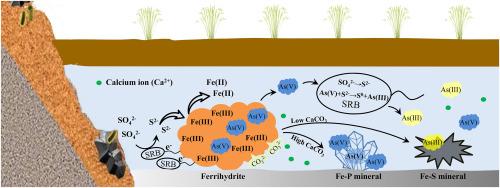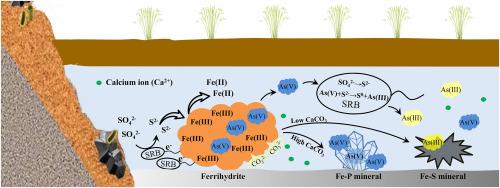碳酸钙对水合铁生物转化及相关砷迁移/再分配的影响
IF 7.3
2区 环境科学与生态学
Q1 ENVIRONMENTAL SCIENCES
引用次数: 0
摘要
硫酸盐还原菌(SRB)诱导水合铁转化是矿区附近含水层砷污染的重要原因。碳酸钙(CaCO3)分布广泛,具有直接或间接调节As命运的潜力。然而,在含srb的环境中,CaCO3对水合铁转化和相关的As动员/再分配的影响尚不清楚。因此,本研究通过批量实验,结合一系列地球化学、光谱和微观技术,共同解决上述研究空白。结果表明,在低CaCO3负荷条件下,水合铁向Fe−S矿物的还原转化导致吸附的As大量释放到溶液中,As(V)还原为更具流动性和毒性的As(III)。SRB细胞内存在S区和As区(不含Fe), As(V)可以被S2-还原而不受Fe(III)的干扰。虽然高CaCO3负荷对Fe(III)的还原影响不大,但它们促进了铁水合体向辉长石和活辉石的转变,并通过结构掺入过程有效地隔离了As,延缓了As的活化。此外,As与杜辉石和活晶石的共析出增强了固相As的稳定性。总体而言,在含srb环境中,高CaCO3负荷显著改变了水合铁的矿物学转化和相关的As生物地球化学。通过添加CaCO3调节水合铁的转化和伴生As的命运是缓解矿区附近含水层As运移的有效途径。本文章由计算机程序翻译,如有差异,请以英文原文为准。


Influence of calcium carbonate on ferrihydrite bio-transformation and associated arsenic mobilization/redistribution
The sulfate-reducing bacteria (SRB)-induced ferrihydrite transformation is an important cause for arsenic (As) contamination in the aquifer near mining area. Calcium carbonate (CaCO3) is widespread and has the potential of regulating As fate directly or indirectly. However, the influence of CaCO3 on ferrihydrite transformation and the associated As mobilization/redistribution in SRB-containing environments remains unclear. Therefore, in this research, batch experiments coupled with a series geochemical, spectroscopic, and microscopic technologies were conducted collectively to address the research gap above. The results suggested that under low CaCO3 loading conditions, the reductive transformation of ferrihydrite to Fe−S minerals resulted in a significant release of adsorbed As into the solution and As(V) reduction to more mobile and toxic As(III). Inside the cell of SRB, there existed S and As zone (no Fe), where As(V) might be reduced by S2− without interference of Fe(III). Although the high CaCO3 loadings exerted little effect on Fe(III) reduction, they promoted ferrihydrite transformation into dufrenite and vivianite, which sequestered As effectively via structural incorporation process, retarding As mobilization. Besides, the coprecipitation of As with dufrenite and vivianite enhanced the stability of solid phase As. Overall, the high CaCO3 loadings altered the mineralogical transformation of ferrihydrite and the associated As biogeochemistry significantly in SRB-containing environments. Regulating ferrihydrite transformation and the associated As fate via CaCO3 addition is an effective approach for mitigation of As mobilization in the aquifer near mining area.
求助全文
通过发布文献求助,成功后即可免费获取论文全文。
去求助
来源期刊

Environmental Pollution
环境科学-环境科学
CiteScore
16.00
自引率
6.70%
发文量
2082
审稿时长
2.9 months
期刊介绍:
Environmental Pollution is an international peer-reviewed journal that publishes high-quality research papers and review articles covering all aspects of environmental pollution and its impacts on ecosystems and human health.
Subject areas include, but are not limited to:
• Sources and occurrences of pollutants that are clearly defined and measured in environmental compartments, food and food-related items, and human bodies;
• Interlinks between contaminant exposure and biological, ecological, and human health effects, including those of climate change;
• Contaminants of emerging concerns (including but not limited to antibiotic resistant microorganisms or genes, microplastics/nanoplastics, electronic wastes, light, and noise) and/or their biological, ecological, or human health effects;
• Laboratory and field studies on the remediation/mitigation of environmental pollution via new techniques and with clear links to biological, ecological, or human health effects;
• Modeling of pollution processes, patterns, or trends that is of clear environmental and/or human health interest;
• New techniques that measure and examine environmental occurrences, transport, behavior, and effects of pollutants within the environment or the laboratory, provided that they can be clearly used to address problems within regional or global environmental compartments.
 求助内容:
求助内容: 应助结果提醒方式:
应助结果提醒方式:


